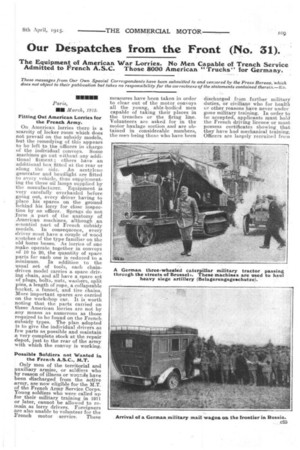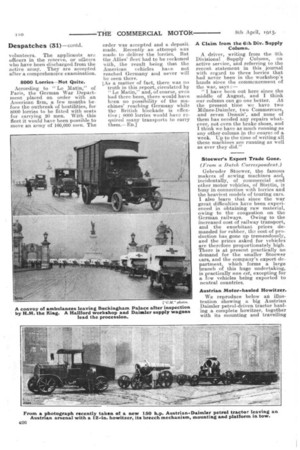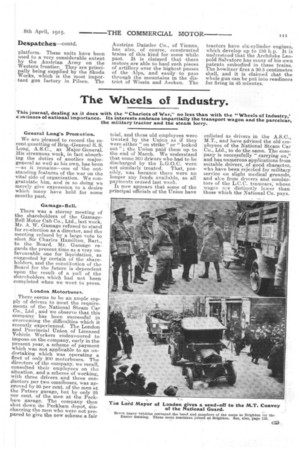Our Despatches from the Front (No. 51).
Page 9

Page 10

Page 11

If you've noticed an error in this article please click here to report it so we can fix it.
The Equipment of American War Lorries. No Men Capable of Trench Service Admitted to French A.S.C. Those 8000 American "Trucks" for Germany,
These messages from Our Own Special Correspondents have been submitted to and cen5ored by the Press Bureau, which does not object to their publication but takes no responsibility for the correctness of the statements contained therein.—ED.
Paris, NM March, 1915.
Fitting Out American Lorries for the French Army.
On American lorries there is a scarcity of locker room which does not prevail on the subsidy models, but the remedying of this appears to be left to the officers in charge of the individual convoys. Some machines go out without any additional fitment-; others have an additional box fitted at the rear or along the side. An acetylene generator and headlight are fitted to every vehicle, thus supplementing the three oil lamps supplied by the manufacturer. Equipment is very carefully overhauled before going out, every driver having to place his spares on the ground behind his lorry for close inspecfion by an officer. Sprags do not :form .a part, of the anatomy of American machines although an essential part of French subsidy models. In consequence, every driver must have a couple of wood scotches of the. type familiar on the old horse buses. As lorries of one .make operate together in convoys of 10 to 20, the quantity of spare parts for each one is reduced to a minimum. In addition to the usual set of tools, each chaindriven model carries a spare driving chain, and all have a spare set of plugs, bolts, nuts, washers, split pins, a length of rope, a collapsable .bucket, a funnel, and tire chains. More important spares are carried on the workshop car. It is worth noting that the parts carried on these American lorries are not by any means as numerous as those required to he found on the French subsidy types. The plan adopted is to give the individual drivers as few parts as possible and maintain a very complete stock at the repair depot, just to the rear of the army with which the convoy is working.
Possible Soldiers not Wanted in the French A.S.C., M.T.
Only men of the territorial and auxiliary armies, or soldiers who by reason of illness or wounds have been discharged from the active army, are noweligible for the M.T. of the French Army Service Corps. Young soldiers who were called up for their military training in 1911 or later, cannot be allowed to remain as lorry drivers. Foreigners are also unable to volunteer for the French motor service. These
measures have been taken in order to clear out of the motor convoys all the young, able-bodird men capable of taking their places in the trenches or the firing line. Volunteers are asked for in the motor haulage section and are obtained in considerable numbers, the men being those who have been discharged from further military duties, or civilians who for health or other reasons have never under. gone military training. In order to be accepted, applicants must hold the French driving licence or must possess certificates showing that they have had mechanical training. Officers are largely recruited from volunteers. The applicants are officers in the reserve, or officers who have been discharged from the active army. They are accepted after a comprehensive examination.
8000 Lorries—Not Quite.
According to "Le Matin," of Paris, the German War Department placed an order with an American firm, a few months before the outbreak of hostilities, for 8000 lorries to be fitted with seats for carrying 20 men. With this fleet it would have been possible to move an army of 160,000 men. The order was accepted and a deposit made. Recently an attempt was made to deliver the lorries. But the Allies' fleet had to be reckoned with, the result being that the American vehicles have not reached Germany and never will be seen there.
As a matter of fact, there was no truth in this report,, circulated by "Le Matin," and, of course, even had there been, there would have been no possibility of the machines' reaching Germany while the British blockade is effective; 8000 lorries would have required many transports to carry them.—En.] A Claim from the 6th Div. Supply Column.
A driver, writing from the 6th Divisional Supply Column, on active service, and referring to the recent statement in this journal with regard to three lorries that had never been in the workshop's hands since the commencement of the war, says :—
"I have been out here since the middle of August, and I think our column can go one better. At the present time we have two Milnes-Daimler, two Commercars, and seven Dennis', and ,none of them has needed any repairs whatever, not even the brake "shoes, and I think we have as much running as any other column in the course of a week. tip to the time of writing all these nrachines are running as well as ever they did."
Stoewer's Export Trade Gone. (Front a Dutch Correspondent.) Gebruder Stoewer, the famous makers of 'sewing machines and, incidentally, of commercial and other motor vehicles, ot Stettin, is busy in connection with lorries and the heaviest models of touring cars. I also learn that since the war great difficulties have been experienced in obtaining raw material, owing to the congestion on the German railways. Owing to the increased cost of railway transport, and the exorbitant prices demanded for rubber, the cost of production has gone up tremendously, and the prices asked for vehicles are therefore proportionately high. There is at present practically no demand for the smaller Stoewer ears, and the company's export department, which forms a large branch of this huge undertaking, is practically non est, excepting for a few vehicles being exported to neutral countries.
Austrian Motor-hauled Howitzer.
We reproduce below an illustration showing a big Austrian Daimler petrol-driven tractor hauling a complete howitzer, together with its mounting and travelling platform. These units have been used to a. very considerable extent by the Austrian Army on the Western frontier. They are principally being supplied by the Skoda Works, which is the most important gun factory in Pilsen. The Austrian Daimler Co., of Vienna, has also, of course, constructed trains of this kind for sortie while past. It is claimed that 'these motors are able to haul such pieces of artillery over the highest passes of the Alps, and easily to pass through the mountains in the district of Wisein and Aecken. The
tractors have six-cylinderengines, which develop up to 150 h.p. it is understood that the Archduke Leopold Salvatore has many of his own patents embodied in these trains. The howitzer fires a 30.5 centimetre shell, and it is claimed chat the whole gun can be put into readiness for firing in 45 minutes.




















